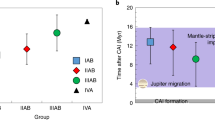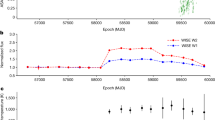Abstract
Many newly formed Sun-like stars show evidence of debris disks composed of dust generated through destructive collisions among residual planetesimals. These are inferred to survive at a detectable level over the first ~100 Myr of their parent star’s lifetime. We hypothesize that the most primitive meteorites were processed as a result of impacts as our Solar System’s debris disk dissipated, rather than as a result of heat generated by decay of 26Al. We show how the iodine–xenon (I–Xe) record from chondrules in the Chainpur meteorite supports this hypothesis, and use it to constrain the decline in the impact rate. We demonstrate that it is the creation of I–Xe sites during compaction that is recorded by the chondrule dataset. We show that, to account for the broader I–Xe record from primitive material, a consistent picture requires that the dissipation of our Solar System’s debris disk had a timescale of around 40–50 Myr in this period. Against this backdrop, the late addition of siderophiles to the Earth in a single large impact may represent a rare phenomenon in planetary system formation that has been anthropically selected.
This is a preview of subscription content, access via your institution
Access options
Access Nature and 54 other Nature Portfolio journals
Get Nature+, our best-value online-access subscription
$29.99 / 30 days
cancel any time
Subscribe to this journal
Receive 12 digital issues and online access to articles
$119.00 per year
only $9.92 per issue
Buy this article
- Purchase on Springer Link
- Instant access to full article PDF
Prices may be subject to local taxes which are calculated during checkout



Similar content being viewed by others
Data availability
All calculations, the source data, code as Visual Basic Excel macros, and the figures and tables are to be found in a macro-enabled MS Excel workbook available at https://doi.org/10.17632/cyy9m2cytv.1. Data used are from the literature and available at the references cited.
References
Siegler, N. et al. Spitzer 24 μm observations of open cluster IC 2391 and debris disk evolution of FGK stars. Astrophys. J. 654, 580–594 (2007).
Wyatt, M. C. Evolution of debris disks. Ann. Rev. Astron. Astrophys. 46, 339–383 (2008).
Bland, P. A. et al. Pressure-temperature evolution of primordial solar system solids during impact-induced compaction. Nat. Commun. 5, 5451 (2014).
Connolly, H. C. & Jones, R. H. Chondrules: the canonical and noncanonical views. J. Geophys. Res. Planets 121, 1885–1899 (2016).
Caffee, M. W., Hohenberg, C. M., Swindle, T. D. & Hudson, B. I-Xe ages of individual Bjurböle chondrules. J. Geophys. Res. 87, A303–A317 (1982).
Gilmour, J. D. et al. Iodine-xenon studies of Bjurböle and Parnallee using RELAX. Meteoritics 30, 405–411 (1995).
Gilmour, J. D. & Crowther, S. A. The I-Xe chronometer and its constraints on the accretion and evolution of planetesimals. Geochem. J. 51, 69–80 (2017).
Holland, G. et al. Iodine-xenon analysis of Chainpur (LL3.4) chondrules. Geochim. Cosmochim. Acta 69, 189–200 (2005).
Swindle, T. D., Caffee, M. W., Hohenberg, C. M., Lindstrom, M. M. & Taylor, G. J. Iodine-xenon studies of petrographically and chemically characterized Chainpur chondrules. Geochim. Cosmochim. Acta 55, 861–880 (1991).
Mostefaoui, S. et al. The relative formation ages of ferromagnesian chondrules inferred from their initial aluminum-26/aluminum-27 ratios. Meteorit. Planet. Sci. 37, 421–438 (2002).
Swindle, T. D., Grossman, J. N., Olinger, C. T. & Garrison, D. H. Iodine-xenon, chemical, and petrographic studies of Semarkona chondrules — evidence for the timing of aqueous alteration. Geochim. Cosmochim. Acta 55, 3723–3734 (1991).
Rudraswami, N. G., Goswami, J. N., Chattopadhyay, B., Sengupta, S. K. & Thapliyal, A. P. 26Al records in chondrules from unequilibrated ordinary chondrites. II thermal metamorphism. Earth. Planet. Sci. Lett 274, 93–102 (2008).
Davison, T. M. et al. Impact-induced compaction of primitive solar system solids: the need for mesoscale modelling and experiments. Procedia Eng 204, 405–412 (2017).
Lewis, R. S., Ming, T., Wacker, J. F., Anders, E. & Steel, E. Interstellar diamonds in meteorites. Nature 326, 160–162 (1987).
Huss, G. R. & Lewis, R. S. Noble-gases in presolar diamonds. 1. 3 distinct components and their implications for diamond origins. Meteoritics 29, 791–810 (1994).
Huss, G. R. & Lewis, R. S. Noble-gases in presolar diamonds. 2. Component abundances reflect thermal-processing. Meteoritics 29, 811–829 (1994).
Gilmour, J. D., Verchovsky, A. B., Fisenko, A. V., Holland, G. & Turner, G. Xenon isotopes in size separated nanodiamonds from Efremovka: 129Xe*, Xe-P3, and Xe-P6. Geochim. Cosmochim. Acta 69, 4133–4148 (2005).
Gilmour, J. D. ‘Planetary’ noble gas components and the nucleosynthetic history of solar system material. Geochim. Cosmochim. Acta 74, 380–393 (2010).
Gilmour, J. D. et al. Xenon and iodine reveal multiple distinct exotic xenon components in Efremovka ‘nanodiamonds’. Geochim. Cosmochim. Acta 177, 78–93 (2016).
Bottke, W. F. et al. Dating the Moon-forming impact event with asteroidal meteorites. Science 348, 321–323 (2015).
Gilmour, J. D. The extinct radionuclide timescale of the early solar system. Space Sci. Rev. 92, 123–132 (2000).
Gail, H. P., Henke, S. & Trieloff, M. Thermal evolution and sintering of chondritic planetesimals II. Improved treatment of the compaction process. Astron. Astrophys. 576, A60 (2015).
Shukolyukov, Y. A., Minh, D. V., Kolesov, G. M., Fugzan, M. M. & Ivanova, M. A. L chondrites. Geochem. Intl. 23, 130–144 (1986).
Wyatt, M. C. et al. Transience of hot dust around Sun-like stars. Astrophys. J. 658, 569–583 (2007).
Brasser, R., Matsumura, S., Ida, S., Mojzsis, S. J. & Werner, S. C. Analysis of terrestrial planet formation by the grand tack model: system architecture and tack location. Astrophys. J. 821, 75 (2016).
Walsh, K. J., Morbidelli, A., Raymond, S. N., O’Brien, D. P. & Mandell, A. M. A low mass for Mars from Jupiter’s early gas-driven migration. Nature 475, 206–209 (2011).
Brasser, R., Mojzsis, S. J., Werner, S. C., Matsumura, S. & Ida, S. Late veneer and late accretion to the terrestrial planets. Earth. Planet. Sci. Lett. 455, 85–93 (2016).
Chechev, V. P. & Sergeev, V. O. Estimating the decay and radiation characteristics of 129I. Meas. Tech. 47, 402–406 (2004).
Brazzle, R. H., Pravdivtseva, O. V., Meshik, A. P. & Hohenberg, C. M. Verification and interpretation of the I-Xe chronometer. Geochim. Cosmochim. Acta 63, 739–760 (1999).
Gilmour, J. D., Crowther, S. A., Busfield, A., Holland, G. & Whitby, J. A. An early I-Xe age for CB chondrite chondrule formation, and a re-evaluation of the closure age of Shallowater enstatite. Meteorit. Planet. Sci. 44, 573–579 (2009).
Gilmour, J. D., Pravdivtseva, O. V., Busfield, A. & Hohenberg, C. M. The I-Xe chronometer and the early solar system. Meteorit. Planet. Sci. 41, 19–31 (2006).
Pravdivtseva, O., Meshik, A., Hohenberg, C. M. & Krot, A. N. I-Xe systematics of the impact plume produced chondrules from the CB carbonaceous chondrites: implications for the half-life value of 129I and absolute age normalization of 129I-129Xe chronometer. Geochim. Cosmochim. Acta 201, 320–330 (2017).
Bouvier, A., Blichert-Toft, J., Moynier, F., Vervoort, J. D. & Albarede, F. Pb-Pb dating constraints on the accretion and cooling history of chondrites. Geochim. Cosmochim. Acta 71, 1583–1604 (2007).
Acknowledgements
This work was funded by the Science and Technology Facilities Council (STFC), UK (grants ST/M001253/1 and ST/J001643/1) and Particle Physics and Astronomy Research Council (PPARC, now STFC), UK (PhD studentship PPA/S/S/2005/04117 awarded to M.J.F).
Author information
Authors and Affiliations
Contributions
M.J.F. contributed to early development of the resetting models, which were reported in her PhD thesis. J.D.G. continued development, interpreted the results, and wrote the paper.
Corresponding author
Ethics declarations
Competing interests
The authors declare no competing interests.
Additional information
Publisher’s note: Springer Nature remains neutral with regard to jurisdictional claims in published maps and institutional affiliations.
Supplementary information
Supplementary Information
Supplementary Figures 1–3, Supplementary Tables 1–2, Supplementary References.
Rights and permissions
About this article
Cite this article
Gilmour, J.D., Filtness, M.J. Dissipation of the Solar System’s debris disk recorded in primitive meteorites. Nat Astron 3, 326–331 (2019). https://doi.org/10.1038/s41550-019-0696-0
Received:
Accepted:
Published:
Issue Date:
DOI: https://doi.org/10.1038/s41550-019-0696-0



